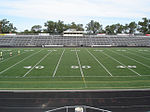Concordia University, St. Paul
1893 establishments in MinnesotaConcordia University (Saint Paul, Minnesota)Educational institutions established in 1893Private universities and colleges in MinnesotaUniversities and colleges affiliated with the Lutheran Church–Missouri Synod ... and 3 more
Universities and colleges in Saint Paul, MinnesotaUse American English from April 2021Use mdy dates from April 2021

Concordia University, St. Paul is a private university in Saint Paul, Minnesota. It was founded in 1893 and enrolls nearly 5,600 students. It is an affiliate of the eight-member Concordia University System, which is operated by the second-largest Lutheran church body in the United States, the Lutheran Church–Missouri Synod. The school was a two year college until 1964. The present name Concordia University, St. Paul was adopted in 1997.
Excerpt from the Wikipedia article Concordia University, St. Paul (License: CC BY-SA 3.0, Authors, Images).Concordia University, St. Paul
Concordia Avenue, Saint Paul Union Park
Geographical coordinates (GPS) Address Nearby Places Show on map
Geographical coordinates (GPS)
| Latitude | Longitude |
|---|---|
| N 44.949722222222 ° | E -93.155 ° |
Address
Concordia University St. Paul
Concordia Avenue
55104 Saint Paul, Union Park
Minnesota, United States
Open on Google Maps







